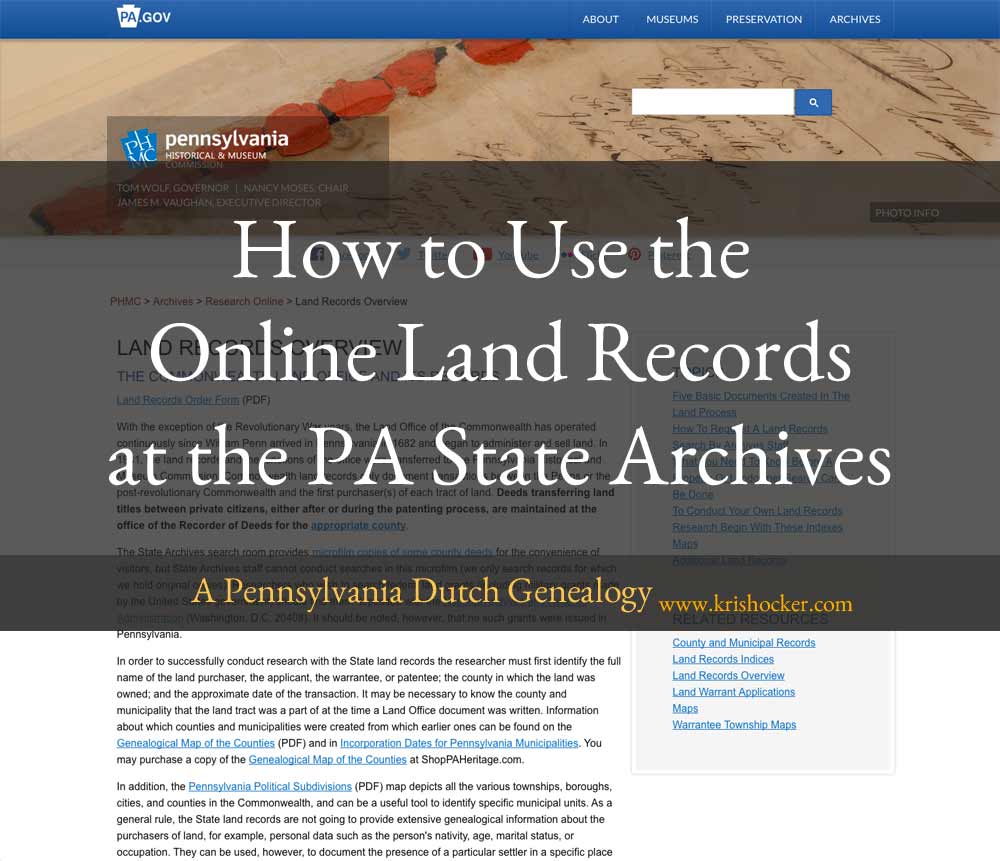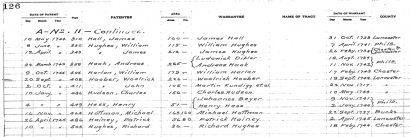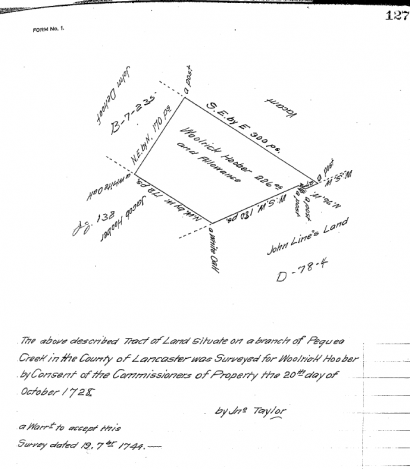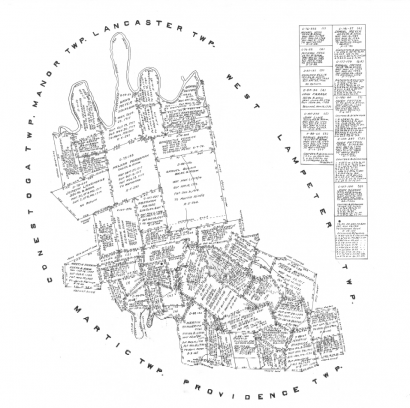How to Use the Online Land Records at the PA State Archives

If you’ve read my blog, you’ll know that I use land records—a lot! I’ve mentioned warrants, patents and deeds in a number of posts. They’re some of my favorite record groups. And best of all, depending on where your ancestor lived, the records may be available online for free.
This blog post is going to explain how to use the land records available online at the PA State Archives. These records are organized by record and then either by county or volume and surname. They have been scanned and placed online as PDFs by page. The records include:
- Warrant Registers
- Copied Survey Books
- Patent Indexes
- Patent Tract Name Index
- Indexes of Selected Original (Loose) Surveys
- East Side Applications (Register)
- West Side Applications (Register)
- Philadelphia Old Rights (Index)
- Old Rights Index: Bucks and Chester Counties
- New Purchase Register
- Original Purchases Register
- Last Purchase Register
- Luzerne County Certified Townships
- Donation Lands
- Depreciation Land Register
- Warrantee Township Maps
- Melish-Whiteside Maps
I’m going to focus on the records in bold.
To understand how to use these records, it’s important to understand how the process worked in Colonial Pennsylvania.1 Technically, William Penn owned all of the land in Pennsylvania. A settler would apply to the land office for land. Before 1687, these applications were typically oral and not recorded. After 1687, they were recorded in the minute books of the Commissioners of Property. The minutes can be found in Pennsylvania Archives, Second Series, Volume 19 and Third Series, Volume 1.
After the application, a warrant was issued to authorize a survey of the land. The warrants I’ve seen specify the name of the warrantee, the location of the desired property (sometimes rather generally), the amount of land, the quit-rent—and sometimes the date from which the rent commences—and the price per acre. The issuance of a warrant, however, does not mean that the applicant actually owned the property.
When a warrant was issued, orders were sent to the surveyor to survey the property and draw a map of the courses and bounds, the acreage, and the neighbors. After a survey was done, the applicant would have to pay for the land and provide evidence of their improvements to the property. In viewing the survey books, there are sometimes multiple surveys of a tract of land. Sometimes the original applicant failed to follow through, sometimes they sold their “rights” to someone else prior to the patent, or sometimes subsequent owners required a re-survey.
Once the survey was complete and the land paid for, a warrant of return was sent to the surveyor general, who in turn sent the survey to the secretary’s office so that a patent could be issued. The patent is the document that transferred ownership of the property to the settler.
So, warrants, patents and surveys deal with transfers of land between the Pennsylvania land office and the settler. Records of land transferred between individuals will be found—if recorded—at the Recorder of Deeds for the appropriate county. This may not be the same as the modern county. For more information on the historical transformation of the counties, take a look at the Genealogical Map of the Counties.
Patents
If you know that your ancestor received a patent for their property, you can begin with the Patent Indexes. How would I know that, you ask. Often, deeds—sometimes several transactions removed from the patent—will reference the original patent for the property. You may have seen something like:
It being the same tract of land which the late Proprietaries of Pennsylvania by their Patent dated the twenty eighth day of September A. Dom. 1744 and recorded at the Rolls Office at Philadelphia in Patent Book A vol 11 page 408 &c did grant & confirm to Ulrich Hoover his heirs and assigns forever…2
If you haven’t seen a reference like this, but want to know if your ancestor was an early landholder, the Patent Indexes are still a good place to start. The Patent Indexes will not only provide the patent book, volume and page number for a patent, but will also identify the name of the original warrantee and the date of the warrant. This will make it possible to locate the warrant and survey if your ancestor was not the original warrantee.
- First, go to the Patent Indexes page on the State Archives site. The records are arranged by series, which are arranged by date. Choose the series you want to review.
- Next find the list of pages for the first letter of your ancestor’s surname. Be prepared to check multiple spellings if they apply. I’ve found “Brenneman” listed under both “B” and “P.”
- Check the available pages to see if your ancestor is listed. Each page is a separate PDF file, so you may need to download and open each file in Adobe Reader if your browser doesn’t have a plugin to view PDF files.
- Each listing includes: series and volume, date of patent, page number, patentee name, area in acres and perches, name of warrantee, name of tract (if available), date of warrant, and county.
If you find your ancestor, make note of the series, volume, page and date of the patent. You’ll need this information if you want to order the patent from the Archives. You should also note the name of the original warrantee, the date of warrrant and the county. This will be necessary for the next step.
In the image above, we have a patent for Woolrick Hoober, dated 20 Sep 1744, with 226 acres in Patent Book A11, page 408. We can also see that he is listed as the original warrantee for a warrant dated 19 Sep 1744 in Lancaster County.
Warrants
Now that you have the name of the warrantee, warrant date and county, you can look-up the warrant and survey information in the Warrant Registers. These registers cover approximately 70% of all land in Pennsylvania for 1733—1957. If the warrant date is 1733 or later, follow these instructions.
- Go to the Warrant Registers page on the State Archives site. The registers are first arranged by county. Click on the link to the appropriate county.
- The pages for each register are listed first alphabetically by the first initial of the warrantee’s surname, then chronologically.
- Check the pages to see if the warrantee is listed.
- Each listing should include: warrant number, warrantee, type of warrant, quantity of land, warrant location, date of warrant, date of return, acreage returned, name(s) of patentee(s), where the patent is recorded (book, volume, page), and where the survey was copied (book, volume, page). Sometimes there are multiple patentees or surveys for each warrant. Sometimes the warrant was vacated and no information is available.
Woolrick Hoober’s listing tells us that he was issued a warrant (#338) to accept a survey of 226 acres in Conestoga Township, dated 19 Sep 1744. The patent was issued 19 Sep 1744 on 226 acres. The patent is listed in Book A11, page 408 and the survey is in book D88, page 127.
If the warrant date was before 1733, you’ll need to check the Old Rights Index for Bucks and Chester counties or the Philadelphia Old Rights Register.
Surveys
With the location of the survey from the Warrantee register, the next step is a piece of cake.
- Go to the Copied Survey Books page.
- Select the appropriate page for the book and volume.
- Click on the page link.
- Each survey should provide either a description of the metes and bounds or a drawing of the tract’s boundaries with the calls and the names of the tract’s neighbors. The survey also usually shows the date of the survey, name of surveyor, who the land was surveyed for, the date of the warrant, and the warrantee.
Ulrich’s survey shows that John Line, Jacob Hoober, and John DeHoof were his neighbors at the time of the survey—20 Oct 1728.
Warrantee Township Maps
Maps for some of the townships were drawn up showing all of the original landholders—those who received the property directly from the Proprietors or the Commonwealth—within the context of the present-day townships. Unfortunately, not every township was mapped.
To find a map of the township were your ancestor held property, you need to know the relationship between the historical township and the modern township. For instance, Ulrich Hoober’s tract was in Conestoga township when he received the patent in 1744. Two modern townships—Conestoga and Pequea—make up the historical 1729 township.3 You can see Ulrich Hoober’s property in the context of the township’s other properties in the Pequea Warrantee Township map.
Don’t forget, using this information you can order a copy of the land warrant or patent from the Pennsylvania State Archives. If you know the reference—warrant number, warrantee and county of warrant for warrants or patentee, patent date, book, volume and page number for patents—you can order an uncertified copy fairly inexpensively. If you don’t have that information, you can also order a search by the staff archivist. That, of course, will cost you more. Warrantee township maps are also available for sale.
If you can visit the state archives in Harrisburg, you can use the information you found through the online records to locate the documents on microfilm, saving time looking up the references so you can research other records.
That’s a fairly quick explanation of warrants, patents and surveys at the Pennsylvania State Archives website. These instructions should work for most properties. However, there will be exceptions (aren’t there always?). If you have questions, leave a comment or drop me a line. I’d be glad to help however I can.
Note: modified to include new PHMC screenshot.
Footnotes
- Pennsylvania State Archives, “Land Records at the Pennsylvania State Archives,” online, viewed 2 Jan 2012. ↩
- John Bowman & ux to John & Henry Breneman (1791), Lancaster County Deed Book PP:730 (online), Recorder of Deeds. ↩
- Lancaster County was founded in 1729 and Conestoga was one of its original townships. Early in its history prior to 1729, the boundaries of Conestoga township included much of Lancaster County. ↩
Cite This Page:
Kris Hocker, "How to Use the Online Land Records at the PA State Archives," A Pennsylvania Dutch Genealogy, the genealogy & family research site of Kris Hocker, modified 21 Mar 2018 (https://www.krishocker.com/how-to-use-the-online-land-records-at-the-pa-state-archives/ : accessed 8 Nov 2024).
Content copyright © 2018 Kris Hocker. Please do not copy without prior permission, attribution, and link back to this page.
14 Replies to “How to Use the Online Land Records at the PA State Archives”
Comments are closed.





Thank you for writing this very helpful explanation. In two of the survey’s I’ve found there is an expression “in right of” separating two names. Both these are cases where a warrant and survey were taken, but no patent was issued to the original warrantee. Can you tell me what this expression means? Thanks again.
John, thanks for the comment.
Since the warrantee technically did not own the land they had warranted—that required a survey and patent—they could not sell it. Instead, they transferred their rights to that land to someone else. Then as long as they followed through on the warrant requirements, that person could then request a survey “in right of” the warrantee and patent the land in their name.
Sometimes the original warrantee received no survey or patent and the land was then warranted to someone else. In those cases, they may have abandoned the warrant or selected land elsewhere. Or they may have failed to follow through on the warrant requirements.
Hope this answers your question.
~Kris
Yes. Thank you. This explains why I can’t find any deeds, indentures, or any other records showing the transfer or sale of the land my ancestor had warranted and surveyed in 1738, but which was not patented until 1785 by someone else. I can see from his will that he was living on the land at the time of his death in 1749, and I can see from later surveys that another relative was living there as late as 1755. I don’t see another warrant or survey for this land however. Maybe getting a copy of the patent would give more information?
Thanks for taking the time to respond. Hope this helps others who may be having the same question.
John, the patent should provide the name and date of the warrantee, name and date of survey, metes and bounds of the property as surveyed, neighbors, and terms. You can see an example of a land patent in John Hoober’s 1736 Land Patent.
Thank you, Kris! I’ll order the several patents for the lands warranted to my ancestors/relatives but patented to others in hopes that there may be references to the transfer of warrantee rights. I’ve looked through all the Lancaster County deed books page by page (thousands of pages, many very hard to read) from the earliest to the late 1780’s without finding actual deeds involving either the warrantees or the patentees for these particular tracts. This will possibly give me another avenue. They were in Lancaster County as late as the early 1750’s per actual documentation, and then they “appear” in Fayette County in 1785 (again per actual documentation). I’m trying to find hard evidence of where they were in between.
This is an awesome site with information given in a succinct and readable form. Awesome job.
Thank you for your kind words, Julie. I’m glad you found it useful and easy to read!
Excellent post on a site that I have become well-acquainted with.
Kris,
Thank you for all the work you’ve done here. You’ve enabled me to find the warrant and survey listings of a couple of my ancestor’s purchases. I never would have tried looking for them without the help I found here.
My ancestor is listed in the Philadelphia Old Rights Index. That index lists two warrants for a survey recorded in Survey Record Book D, Vol. 75, pages 68 and 69. I found these and discovered them to be copies made in 1909.
Can I assume that if I ordered copies from the State Archives that I would get a copy of the (microfilmed) original record made in 1683 and 1684?
Secondly, I want to find/order a copy of the patents. So, do I need the date of the patent and the Vol. Book an page numbers? I take it that these are not identical to the survey volume, boo,k and page numbers.
Thank you for the feedback, Robert. I’m so glad you found this post useful!
To the best of my knowledge the copied survey is all that’s available for the survey. I could be wrong, though. The best place to get more information would be from the Archivist at the State Archives. You can reach them via email at ra-statearchives@pa.gov.
To order a copy of the patent you need the name of the patentee, the date of the patent, the volume, book and page number. Since these are not listed in the Old Philadelphia Rights, you should try looking them up in the Patent Registers for series A and AA, 1681-1781. There is a listing there for John Test (warrant dated 13 Nov 1784 to John Test; patent to John Test, dated 17 Nov 1684, Patent Book A1:58) for a Philadelphia city lot (see patents for surname starting with T, page 309). This looks like it might fit with survey D75:69. It’s possible he never got a patent for D75:68. Check the reverse pages for D75:68 & 69 to see if there’s additional information you could provide the archivist.
Hope that helps. Good luck & let me know if you find anything more!
Kris
Wow! I can’t believe you took the time to look up the patent. Thank you.
I think I had scanned through those pages but totally missed it.
I notice on the patent that the date of the survey is given as Nov. 13, 1684 and that “matches” the date of “13th 11th mo 1684 of the survey. So I agree the survey on p 69 matches with this patent.
Interesting that the person who copied the material interpreted the 11th month to be November when, in fact, in 1684 the 11th month was actually January.
Absolutely fantastic post! Like you, I love using land records for the research. Like the old adage says, “Follow the money,” and almost nothing was more valuable than land. You may be interested in a few articles I wrote about the land patent process in Maryland (another proprietary colony) a few years ago. See http://www.examiner.com/genealogy-history-in-baltimore/colonial-maryland-land-patents-and-headrights and http://www.examiner.com/genealogy-history-in-baltimore/researching-colonial-maryland-patent-records and http://www.examiner.com/genealogy-history-in-baltimore/colonial-maryland-patented-and-unpatented-certificates
Thank you, Michael. I’ll have to check the posts out because I’ve got quite a bit of Maryland research to do, too!
[…] written about how to use the online land records at the Pennsylvania State Archives, it’s only fair that I provide examples of what each document […]